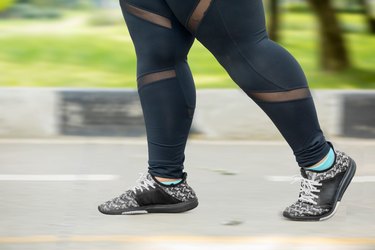
Regardless of your weight, starting an exercise routine is an important step toward your healthiest you.
In fact, if you have obesity and you're active, you're more likely to be more metabolically healthy with better blood glucose, blood pressure and lipid levels — important factors for mitigating heart disease and diabetes risk, according to January 2018 research in BMC Obesity.
Video of the Day
Video of the Day
Though exercise alone may not lead to significant weight loss (it's important to combine activity with a healthy diet), where it does shine is in helping dieters more easily maintain weight loss (if that's your goal), per a January 2014 review in Progress in Cardiovascular Diseases.
Still, you may be worried about how to start an exercise routine, especially as someone in a bigger body. "I was once obese. One of the biggest challenges I faced was the physical ability to actually exercise. My body hurt from the extra weight, and my endurance was extremely low," Katie Hug, certified personal trainer and health and wellness coach, tells LIVESTRONG.com.
Those are all legitimate concerns, but they don't have to be barriers. "There are several things you can do to make the exercise program less stressful on your body," says exercise physiologist Alicia O'Connor, director of personal training at the Medical University of South Carolina's (MUSC) Wellness Center.
These 11 steps are great ways to get started. Don't worry about doing all of them at once; know that each one you take gets you closer to a fitter version of you. The very first step? Get the go-ahead from your doctor. Chat through your goals and get cleared to start an exercise routine — then dive in.
Read more: Discover Your Ultimate Weight-Loss Workout Plan
Step 1: Rethink the Notion of 'Exercise'
You know how the folks on The Biggest Loser would work out for hours a day, running themselves ragged and even puking? Forget them: That is not what it needs to look like for anyone starting an exercise program.
"People have visions of what they think exercise is supposed to be and look like from TV, so they come into exercise already having talked themselves out of it. They don't think they can do whatever their preconceived notion is," Chris Gagliardi, personal trainer and spokesperson for the American Council on Exercise (ACE), tells LIVESTRONG.com.
Keep in mind that the idea that you have to exercise for a certain amount of time, breathe hard or sweat a ton doesn't really mean anything. "Who says that's how exercise has to be? I encourage clients to focus on what they can do," Gagliardi says.
Establish your baseline: Can you do a bicep curl? How many? Can you walk for 10 minutes? How much time do you spend sitting? Your goal isn't to stick it out for a 60-minute cycling class when you don't like to bike. Rather, it's to work with what you've got, build on small successes and keep your motivation going.
Step 2: Find Your Place
You don't have to work out at a gym. However, if you choose to join one, let's face it: They can be overwhelming. "It's very common to feel out of place and intimidated," Hug says. What helped her was finding a gym where she felt "at home."
If you're interested in finding your fitness home, tour a few gyms in your area and get a feel for how supportive and welcoming the environment is. It should feel like somewhere you want to go.
Step 3: Consider Enlisting Professional Help
If you're unfamiliar with gym equipment, meet with a certified personal trainer who can show you how to safely set up and use the machines. "Proper form and the correct weights and machines are very important for injury prevention and successful muscle gain," Hug says.
Tip
Many gyms will offer a complimentary personal training session when you join. Don’t feel pressured to continue if it’s not for you or not in your budget.
Step 4: Set an Obtainable Goal
Start with a realistic plan for the details of your workout. Decide when, where and how long you're going to exercise, Hug says. This can be something as simple as vowing to walk for five minutes around your block, she says. Trying out an elliptical or a recumbent bike at a local gym are other great options, she says. "Stay consistent with whatever you choose," she says.
Tip
Add your workout to your calendar to help you stick to this important “appointment,” Hug says.
Step 5: Mind Your Joints
A heavier body puts more stress on the joints. "When starting an exercise program, you want to make sure that you are looking out for your joints, like knees, ankles and hips," O'Connor says.
One of the gentlest workouts to try: pool exercises. Do them as part of an organized aqua class with an instructor at a local community center, take 20 minutes to do laps during open swim or simply walk in the water. "Walking in the pool is amazing. It will save your joints," O'Connor says.
Step 6: Watch the Intensity
You'll want to hit that sweet spot: You're challenging yourself enough to get results, but you're not going so hard that you'll have to quit just minutes in. But no one can really tell you what the best resistance on the elliptical or speed on the treadmill is for you. That's where something called the talk test comes in handy.
Move at enough of a clip that you could still hold a conversation with a gym buddy, according to O'Connor. If you could belt out a Mariah Carey song, you're moving too slowly.
Or, think of your workout intensity on a scale of one to 10. One is resting in bed and 10 is running from a bear, says O'Connor: "Move with purpose — you should hit a six or seven."
Step 7: Ramp Up Gradually
If you're feeling motivated by all you stand to gain from your new workout routine, you might be tempted to do too much too soon. For instance, if you start walking for an hour a day, you could put yourself at risk for stress fractures in your feet. "There is no future in [going hard and intense]," O'Connor says. "You need to approach an exercise program more gradually."
After a five-minute walk every other day starts to feel easy, try it every day. Then up the ante to 10 minutes in the morning and 10 at night, three times a week, O'Connor recommends. Keep building bit by bit until you reach the 150 minutes a week of moderate-intensity exercise recommended by the Department of Health and Human Services Physical Activity Guidelines for Americans.
Watch for Overtraining
Exercise may feel uncomfortable, but it should not be acutely painful. “No pain, no pain. That’s how we train,” O’Connor says. Signs you're overdoing it include joint pain or all-over body aches, she adds. Listen to your body. If you’re feeling pain, back off or scale down your routine.
Step 8: Add Smart Strength Training
For clients with obesity, O'Connor recommends strength training the upper body only to start. "Walking is providing you with all of the lower-body strength you need," she says. For the upper body, a great place to start is with push-ups on a wall or countertop. "This move works nearly all the muscles in your upper body and core," she says.

- Place your hands on the counter or wall just outside of shoulder-width apart.
- Lower down and bend your elbows to 90 degrees
- Push back up to start.
Tip
Once countertop level feels relatively easy, move down: Place your hands on a couch or a bench at the gym. Still too easy? Move your push-ups to the floor.
Form is crucial when you're starting a strength-training routine, and that's where choosing the right weight comes in. Mike Fantigrassi, an expert with the National Academy of Sports Medicine (NASM), recommends choosing lightweight dumbbells to start. You should be able to perform 12 to 20 repetitions of an exercise with proper form with that weight. If you can easily finish more than that, grab heavier weights. If you can't get to 12, go lighter.
Watch your form in a mirror and don't rush. "When you move slowly, it places more stress on muscles and less on tendons and ligaments," Fantigrassi says. Ultimately, that's more effective — and safer — for you.
Step 9: Stabilize Your Knees
Physical therapy-type exercises can help keep your knees healthy, says O'Connor.
Glute Bridge
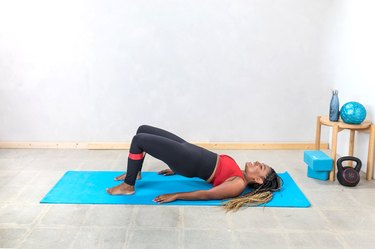
- Lie on your back, knees bent to 90 degrees with your feet on the ground (with or without a mini resistance band around your calves).
- Press through your heels to lift your hips toward the ceiling.
- Slowly lower back down.
Banded Lateral Walk

- Place a mini resistance band around your legs above your knees.
- Keeping resistance in the band, take side-to-side steps.
- Repeat in the other direction.
Side Kick

- Place a mini resistance band around your ankles
- Stand, holding onto a countertop or the back of a chair for stabilization if needed.
- Without moving your upper body, lift one leg out to the side.
- Repeat on the other leg.
Step 10: Strengthen Your Core
A strong core is vital for posture, balance and reducing lower back pain. But you don't have to do crunches! Fantigrassi recommends starting with these three exercises.
Quadruped
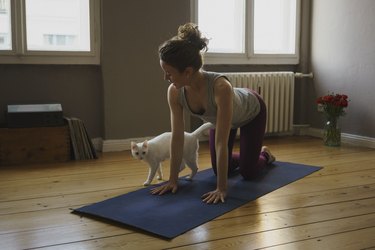
- Start on the floor on your hands and knees in a tabletop position. (Cushion your knees with an exercise mat or a towel if necessary.)
- Engage your core to draw your belly button into your spine.
- Hold for 10 to 30 seconds, release and repeat.
Bird Dog
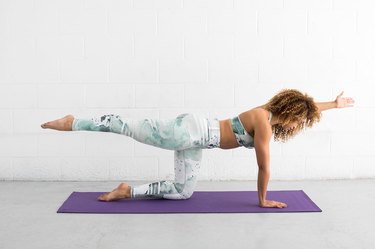
- On hands and knees, extend your right leg behind you and reach forward with your left arm. Hold.
- Return to the start.
- Repeat on the left leg and right arm for desired number of reps.
Forearm Plank
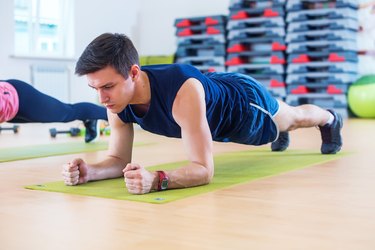
- On your knees, walk your hands forward until you're in a modified push-up position. (Your back and butt should be in a straight line.)
- Place your forearms on the ground and lift your knees so your back forms a straight line.
- Hold for 10 to 30 seconds.
Read more: The 'So You Feel Like Crap' Guide to Fitness
Step 11: Give Yourself a Pat on the Back
You're doing it. That can be tough to remember when you have inevitable setbacks or aren't reaching your goals as fast as you'd like, but keep perspective. "When you think you're not making progress, I promise you are," Hug says. "Think of it as building a healthy body from the inside out. Your body will fluctuate, but if you stay consistent, you will see results."
- BMC Obesity: “Association Between Cardiorespiratory Fitness and Metabolic Risk Factors in a Population With Mild to Severe Obesity"
- Progress in Cardiovascular Diseases: "The Role of Exercise and Physical Activity in Weight Loss and Maintenance"
- U.S. Department of Health and Human Services: "Physical Activity Guidelines for Americans"